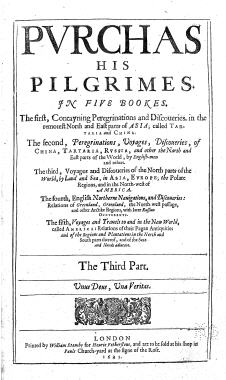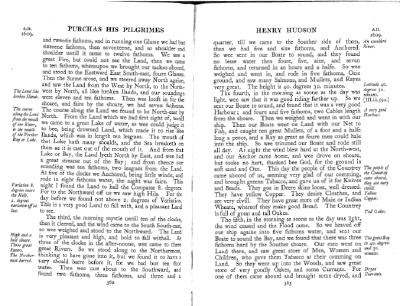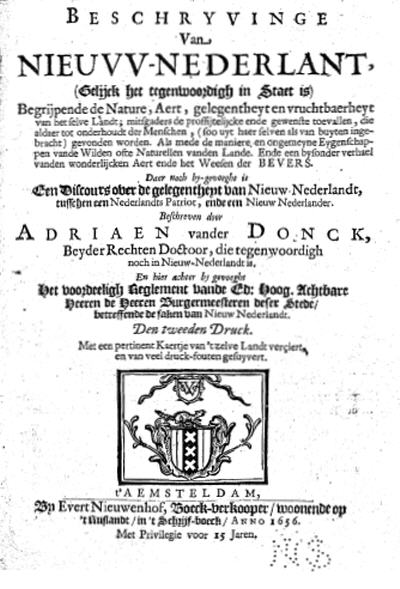People going on journeys sometimes keep a daily record of what they see and do. These records are called journals or diaries. Some journals contain brief entries about events; others include observations and opinions of a reflective nature.
Here are four journals and one book written about the land and the people of the Hudson and Mohawk river valleys in 1609, 1634-5, 1641-8, 1784 and 1800.
In 1609 Henry Hudson set forth on his third trip in search of a northwest passage to the Orient. One of the men sailing with him on that voyage - the voyage that led to Hudson's sailing up the Hudson River - was Robert Juet (pronounced Jew-ett). Juet kept a journal which was published in a 1625 compilation of documents related to explorations published by Samuel Purchas. (The whereabouts of the original 1609 journal is unknown.)

The Hudson River portion of the trip was reprinted in 1905-1907. (Purchas, Samuel. Hakluytus Posthumus, or Purchas His Pilgrimes: Contayning a History of the World in Sea Voyages and Lande Travells by Englishmen and Others. NYSL call number: C,910.8,P98)

A 1909 reprint included annotations using modern-day place names: Catskill, Stony Point, Poughkeepsie, etc. (Jameson, J. Franklin. Narratives of New Netherland, 1609-1664. NYSL call number: R,974.7,J31)
In 1614 or 1615, just five years after Juet had seen and written about the river that came to bear Hudson's name, the Dutch West India Company established a trading post called Fort Nassau on an island just a stone's throw from what became Albany, N.Y. on the western shore of the river. In 1624 a second, new trading post, named Fort Orange, was built on the mainland. The purpose of the forts was to serve as a place to trade with the natives. Trade in furs, especially beaver fur, soon proved highly profitable. However, in the early 1630s the fur trade had begun to decline. Thus, in the winter of 1634 the commander of Fort Orange sent Harmen Meyndertsz van den Bogaert and two others west into the Mohawk Valley to learn why the fur trade had dropped off. The journey lasted six weeks and Van den Bogaert kept a journal, describing Indian villages, food, the environment, etc.
[images of pages from In Mohawk Country ... ]
Snow, Dean R. (editor)
In Mohawk Country: Early Narratives about a Native People. (Syracuse, N.Y.: Syracuse University Press, 1996), pp. 1-13 (NYSL call number: R,974.7602,M697,97-11167)
The book contains 38 first-hand descriptions of life in the Mohawk Valley between 1634 and 1810, ending with De Witt Clinton's private canal journal, written in 1810.
While not a journal, the "description" of New Netherland written by Adriaen van der Donck provides a very detailed, first-hand account of what he remembers about New Netherland as it was in the 1640s.
Adriaen Cornelissen van der Donck studied law in the Netherlands. In 1641 Kiliaen van Rensseler, former director of the West India Company and patron of Rensselaerwijck, hired Van der Donck to serve as the sheriff/prosecuting attorney on his manor. He returned to the Netherlands in 1648 to defend himself in a lawsuit. Following the settling of the case, Van der Donck was refused permission to return to New Netherland until 1653. While in exile, he wrote Beschryvinge van Nieuvv-Nederlant (Description of New Netherland); the book was published in 1655 and reprinted, with a map, in 1656.
Provided are images of the pages from the original, written in Dutch, and a recent translation as published in In Mohawk Country: Early Narratives about a Native People. Students may be able to identify some of the Dutch words because of their similarity to English.

Beschryvinge van Nieuvv-Nederlant (gelijck het tegenwoordigh in staet is). (t'Amsteldam, By Evert Nieuwenhof, boeck-verkooper woonende op't Ruslandt in't Schrijf-boeck, anno 1656)
NYSL call number: V,917.47,D67
[images of ENGLISH TRANSLATIONS of copies of Van der Donck's book dealing with Indian castles and homes and with zeewant/wampum from In Mohawk Country ...]
These pages - pages 110, 112, 113, 119 - have not been scanned. They replace the Johnson translation on the CD.
Snow, Dean R. (editor)
In Mohawk Country: Early Narratives about a Native People. (Syracuse, N.Y.: Syracuse University Press, 1996), pp. 1-13 (NYSL call number: R,974.7602,M697,97-11167)
The book contains 38 first-hand descriptions of life in the Mohawk Valley between 1634 and 1810, ending with De Witt Clinton's private canal journal, written in 1810.
In 1784 Peter Sailly emigrated to the United States from France. He kept of journal of his trip of May 11 through July 10 from Philadelphia up the Hudson River to Albany, west along the Mohawk River as far as Fort Stanwix and a nearby Oneida Indian village and back to Albany before heading up the Hudson toward Plattsburgh where he eventually settled. This trip was taken about a year after the treaty ending the American Revolution was signed.
Bixby, George Stephenson. Peter Sailly (1754-1826): A Pioneer of the Champlain Valley with Extracts from His Diary and Letters. (Albany: University of the State of New York, 1919), pp. 58-63. (New York State Library History Bulletin 12/University of the State of New York Bulletin, No. 680)
These pages - pages 58-63 - have not been scanned.
John Maude, an Englishman, spent the summer of 1800 traveling in New York State and eastern Canada. The journal, published in 1826, is annotated with information the publisher gleaned from the second edition of a gazetteer published in 1797 (Morse, Jedidiah. American Gazetteer, Exhibiting in Alphabetical Order, a much More Full and Accurate Account, Than Has Been Given, of the States, Provinces, Counties, Cities, Towns, Villages, Rivers, Bays, Harbours, Gulfs, Sounds, Capes, Mountains, Forts, Indian Tribes, New Discoveries, on the American Continent … : (Boston: At the Presses of S. Hall, and Thomas & Andres …, 1797). The Hudson River and Mohawk River portions of his trip, from New York City to Oneida Castle are included here.
Maude, John. Visit to the Falls of Niagara in 1800. (London: Longman, Hurst, Rees, Orme, Brown Green, 1826)
These pages - pages 3-37 (June 21-July 3) - have not been scanned.